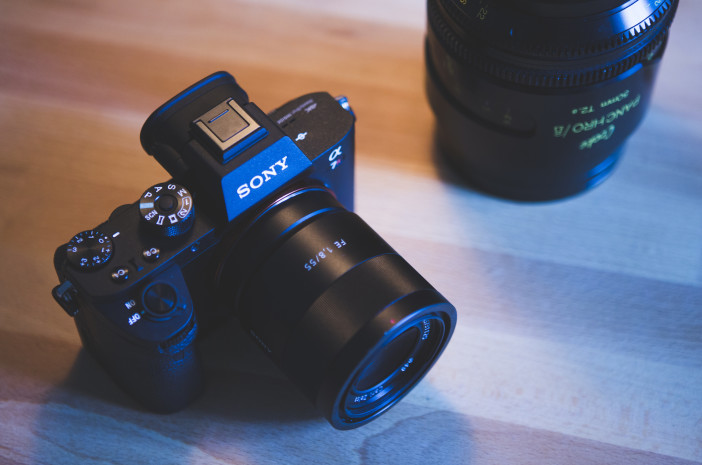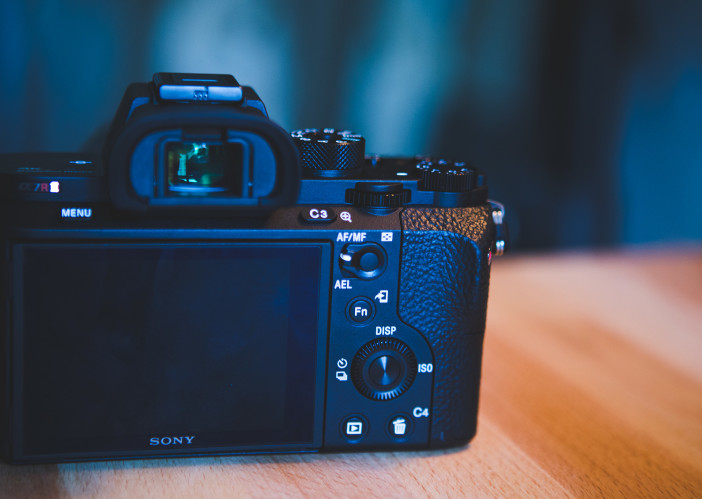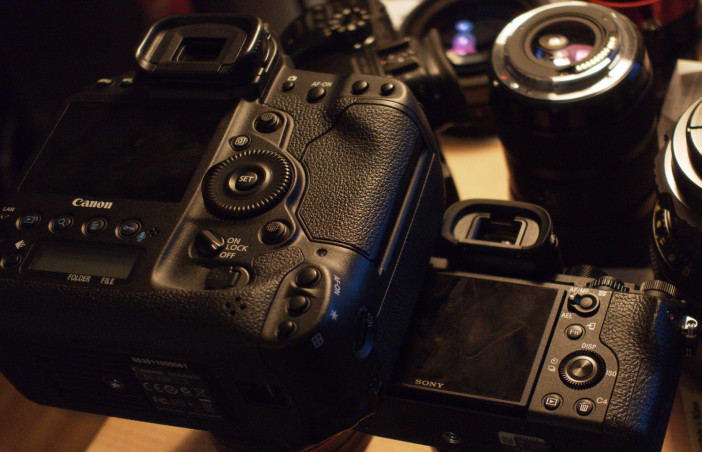EOSHD is now 5 years old and 5 years proudly advertising free. I want it to stay 100% impartial. I grew up with the BBC and they are the role model for me. No advertising on EOSHD. Nice rhyme to it doesn’t it?!
In part 1 of the Sony A7R II review we will look at the A7R II not as a consumer camera but as a professional cinema camera.
The benchmark for this camera is going to be the Canon 1D C.
The Sony A7R II is an amazingly innovative camera.
It’s as hot as hell. In more ways than one as we’ll find out in a moment.
However I have a room full of candles and crucifixes and I am sitting in the middle of a circle of fire to ward off evil demons. Why? Because I am going to criticise The Best Camera In The World. The A7R II is not quite the Jesus camera everybody has been saying it is. There’s no easy way to put this, no palatable way to break it down, no extreme viewpoint that suits the A7R II. It’s just an incredibly complicated and multilayered filmmaking tool… not a “game changer” and not “rubbish” either.
The best 4K stills camera yet though?
When 4K video first appeared on the Panasonic GH4 it was a relief. After years of mushy compressed pixel binned 1080p the image was a huge leap up. My favourite series had its mojo back. Suddenly though a huge 35mm long carrot loomed into view and that was the Sony A7S.
Sadly this only shot 4K through the worst cable known to man, an HDMI cable.
Then came the Samsung NX1 with it’s gloriously un-editable H.265 codec but really quite amazing bang-for-buck especially considering the technology under the hood. If Samsung keep improving at the rate we saw between the NX30 and NX1 they will have cameras on the moon in just 2 years. The NX1 however is in some ways an astronaut on the way to Mars without a spare pair of underpants. It has a video mode that keeps defaulting to continuous AF at the start of every clip when you have selected manual focus and that is like forgetting to close the door properly on the lunar module before you take off.
Then came the Canon 1D C drifting into the world of sanity after pros began to sell it off on eBay for less than $5000. This originally cost $12,000. LOL! And when you look at the image you will discover why.
Finally comes the Sony A7R II which if it were a weapon would be an amazingly specced plasma gun, you just hope and pray that the trigger works on it.
Unfortunately it doesn’t! You cannot shoot movies with the main shutter release button.
Joking aside, it does have its flaws. Usually reviewers come back from their PR jaunts and put these at the end of the review. I’m going to readdress the balance and put them at the start. I went out and bought the Sony A7R II with my own money so I am allowed to do this…
The moire and aliasing in full frame 4K mode is not quite the free lunch it has been made out. I find it worse than expected (see below).
https://vimeo.com/135670483
The amount of rolling shutter distortion in Super 35mm crop mode is amongst the highest of all the 4K cameras around today (see below).
https://vimeo.com/135669482
Colour from the camera in 4K video mode is good but not as nice what you get with the 1D C in Canon LOG and definitely not as easy to grade as Nikon’s flat picture profile on the D750.
The menus are still too complicated and convoluted with too many nannying messages popping up during a shoot. The camera isn’t fast enough to boot up for a stills camera and it’s not as responsive as it should be. Although AF with Sony lenses is vastly improved, the reliability of it is hit and miss. AF with Canon EF lenses is still way off the mark as well.
Specs war and an 8K full frame sensor
Sony’s goal for the full frame sensor in the A7R II is quite simply to make the best 35mm photographic sensor in the world and the cherry on top is 4K video. Clearly in the last few years Sony have really stepped things up in the CMOS sensor world. The incentive to channel huge resources into sensor R&D is in part due to the booming smartphone market. Sony supply the majority of it with camera sensors, so that users can take pictures of themselves in bathrooms and selfies in front of landmarks where you don’t see the landmark because there’s a head in the way.
The Sony A7R II’s 42MP BSI full frame sensor is the Sony CMOS magicians off the hook and pulling out all the stops. All 14 of them for dynamic range. The A7R II’s 42MP sensor is a remarkable feat of engineering even before considering the 4K video capabilities and 5 axis image stabilisation.
Canon left out these features on the more expensive 50MP 5DS due to the heat dissipation challenges. Sony have managed to do it even in a much smaller body with the sensor on a floating block for 5 axis stabilisation. This means it is disconnected from a heat sink and there is of course no fan to cool it either. Canon have yet to solve the heat challenges of 4K video from a massive 50MP full frame sensor even though they had a larger body and their sensor isn’t floating in thin air.
However in many ways Sony have yet to solve the heat challenges of 4K video either.
The A7R II can be a real heat cannon and gets very hot to the touch during a shoot. After around 30 minutes of 4K recording in Super 35mm mode and 45 minutes in full frame mode the camera reliability drops to the point where you may begin losing shots due to overheating warnings.
This does not happen on the Canon 1D C in 4K or the Panasonic GH4 and Samsung NX1, also in 4K.
One thing I can see happening from the third party rig companies for this camera is some kind of fan accessory built into a cage!
Canon recently admitted in an interview that ‘yes, we are slow’ but they have heat issues to solve before they will bring 4K to their consumer DSLR lineup, so who am I to doubt them now because you can practically fry eggs on the front of the A7R II and the RX100 IV doesn’t go for longer than 5 minutes before it has to sit down and take a cold shower.
Thankfully the cooling off period is quite short, but it makes me appreciate the 1D C even more because for the first time I realised Canon weren’t bullshitting then they said the 1D C was not just a 1D X with a firmware update but a new camera with complicated thermal issues solved. In fact the keenness to keep the 1D C’s firmware out of our hands (service stations only install it) was perhaps to avoid a spate of damaged 1D Xs due to being pushed beyond their usual thermal limits.
Fact is doing 4K on a very high resolution full frame sensor is hard.
14 stop dynamic range and 42MP are one thing, you then realise it’s an 8K sensor larger than the RED Dragon’s that does 5K video in Super 35mm mode whilst floating in thin air, with the backend recording 4K to tiny SD cards and in full frame there’s no line skipping but an intelligent pixel binning process to give us 4K in that mode too.
That goes way beyond what anybody expected from a high resolution stills camera in 2015. In terms of the sheer force of technology and specification the A7R II is like a mini FS7 for less than half the price. It is like a full frame GH4 which can do clean ISO 6400 with 5 axis in-body stabilisation.
So am I happy to see this innovation? Am I happy to put up with the potential for overheating on a shoot? Yes. In fact for the price of one FS7 you can get two A7R II and use one as a backup body to let the other cool down and I’ve always preferred to have the option of a full frame sensor in a tiny body over a Super 35mm sensor in a much larger professional cinema camera (even though the Epic and FS7 are small by cinema standards).
S-LOG vs Canon LOG
Colour is so important. It’s the difference between a beautiful actress looking healthy or ill. It’s the difference between a hazy blue sky at dawn and a plain old grey one in the afternoon, the difference between zero emotional response and a sublime spine tingling one.
Forget 8bit and forget 4:2:0 for a moment, I have always felt the Sony and Panasonic cameras had a ‘thinner’ colour in the video files when compared to the 8bit 4:2:2 Canon LOG I get out of the 1D C, which goes to show the problem is not all about 8bit.
What goes on with the GH4, NX1 and now the A7S? Does compression hurt? Does 4:2:0 throw too much away? I don’t know but the A7S did not give me the same satisfaction the Canon 1D C did in MJPEG at 500Mbit/s.
Now my first impressions of the A7R II are the same, it just doesn’t feel as right as the 1D C in terms of colour. However this isn’t my final conclusion as I’m still discovering the right colour path for the camera and developing my LUTs and in-camera picture profiles.
Rarely do you have a problem with colour on a modern camera that can’t be solved in post.
However this is certainly a more convoluted process than getting nice results out of Canon LOG and it has taken me a lot of time.
I also find the Samsung NX1 and Panasonic GH4 do not come up to the mark set by Canon in their JPEGs and they seem to collect far more green than any other hue, which tends to wash over subtle yellow, orange and blues in the atmosphere, on foliage and crucially on skin. Same in video mode vs the 1D C’s MJPEG 4K. How often have I had to correct greenish / magenta-isn skin tones on a Panasonic GH4 or Sony A7S? Too many times to mention.
It’s no surprise to me that the digital cameras on the market that deliver the best colour are by companies who used to make film – Fuji (X-T1 JPEGs are a thing of beauty) and Kodak (who designed the CCD sensor in the Digital Bolex). Canon are right up there with them and so are their lenses which seem optimised for warm skin tones.
Sony have come a long way and the FS7 with S-LOG 3 is getting closer to film and the wide colour gamut on the Sony F65 is actually better than film (on paper)! The Sony A7 series though needs to take a page from the Canon & Nikon book for JPEGs and 4K video.
Handling
Sony seem to have worked 50% down a list of feedback and then run out of time. Build quality is certainly a step up from the A7S and original A7R though. The new body is essentially the same as the A7 II in terms of ergonomics. I quite like it. The EVF seems to be a bit more immersive this time too.
This is a good body considering it comes from Sony’s consumer division and has to address the needs of the casual user and not just the pros.
Sony can do a lot to improve it though just by looking at the Canon 1D X.
Firstly the back panel is not the same shape or size as an adult hand. It isn’t even the same size as a Pikachu’s hand. The body does not fall away around the dials enough. Especially with the rear aperture / shutter dial I feel like I am stroking the back of the body more than the actual dial. I love the A7R II but I don’t love it THAT much!!
The rear dial and d-pad is on the small side, my thumb is much bigger than it so it borders on the fiddly. The articulating screen sets of the eye sensor for the EVF when you extend it into a certain position, that just shouldn’t happen. Did anyone spot this in testing? The mode dial has an ‘idiot lock’ on it which we don’t need. Indeed a professional stills camera like the 1D X doesn’t have a mode dial at all and I don’t really see why the mode can’t be selected through a quick menu instead and the space on top of the camera used for a much more useful LCD info panel like on the Samsung NX1, Canon 5D and 1D C.
The menu systems are where Sony really need to overhaul their design the most though. The Sony FS7 suffered the same fate. The main issue I have with the user interface of the A7R II and the A7S is that it just takes too many presses to get through. There are too many pages, too many rows and too many squares.
Part 2
The Sony A7R II is a fascinating camera and tons of fun to shoot with. When compared to cream of the crop from last year, the GH4, NX1 and A7S, the A7R II is overall the better all-round camera for both video and stills. Astounding 42MP photos, completely new sensor and internal 4K recording from a full frame sensor, despite heat issues. Only it doesn’t quite scale the heights for 4K video quality when compared with cinema cameras. The Canon 1D C has the character, the film-like grain, the extensive colour gamut and the damned high price to go with it. Also I feel that in the rush to bring you the specs of the future the camera lacks a bit of refinement.
The A7R II is an iceberg and we are at the tip so I will have much more to come from this camera on EOSHD in the coming days.
I also have the Part 2 / final review almost finished for the Sony RX10 II and Sony RX100 IV.






